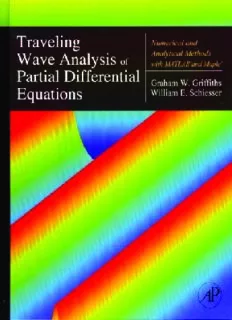Table Of Content“01-fm-i-iv-9780123846525” — 2010/12/8 — 15:29 — page 1 — #1
Traveling Wave Analysis of
Partial Differential
Equations
“01-fm-i-iv-9780123846525” — 2010/12/8 — 15:29 — page 3 — #3
Traveling Wave Analysis of
Partial Differential
Equations
Numerical and Analytical Methods
(cid:114)
with MATLAB and Maple™
Graham W. Griffiths
CityUniversity,London,UK
William E. Schiesser
LehighUniversity,Bethlehem,PA,USA
AMSTERDAM•BOSTON•HEIDELBERG•LONDON
NEWYORK•OXFORD•PARIS•SANDIEGO
SANFRANCISCO•SINGAPORE•SYDNEY•TOKYO
AcademicPressisanimprintofElsevier
“01-copy-iv-9780123846525” — 2010/12/8 — 15:25 — page 4 — #1
AcademicPressisanimprintofElsevier
30CorporateDrive,Suite400,Burlington,MA01803,USA
TheBoulevard,LangfordLane,Kidlington,Oxford,OX51GB,UK
Copyright©2012ElsevierInc.Allrightsreserved.
Nopartofthispublicationmaybereproducedortransmittedinanyformorbyanymeans,electronicor
mechanical,includingphotocopying,recording,oranyinformationstorageandretrievalsystem,without
permissioninwritingfromthepublisher.Detailsonhowtoseekpermission,furtherinformationaboutthe
Publisher’spermissionspoliciesandourarrangementswithorganizationssuchastheCopyrightClearance
CenterandtheCopyrightLicensingAgency,canbefoundatourWebsitewww.elsevier.com/permissions
ThisbookandtheindividualcontributionscontainedinitareprotectedundercopyrightbythePublisher(other
thanasmaybenotedherein).
MATLAB(cid:114)isatrademarkofTheMathWorks,Inc.andisusedwithpermission.TheMathWorksdoesnotwarrant
theaccuracyofthetextorexercisesinthisbook.Thisbook’suseordiscussionofMATLAB(cid:114)softwareorrelated
productsdoesnotconstituteendorsementorsponsorshipbyTheMathWorksofaparticularpedagogical
approachorparticularuseoftheMATLAB(cid:114)software.
Notices
Knowledgeandbestpracticeinthisfieldareconstantlychanging.Asnewresearchandexperiencebroadenour
understanding,changesinresearchmethods,professionalpractices,ormedicaltreatmentmaybecome
necessary.
Practitionersandresearchersmustalwaysrelyontheirownexperienceandknowledgeinevaluatingandusing
anyinformation,methods,compounds,orexperimentsdescribedherein.Inusingsuchinformationormethods
theyshouldbemindfuloftheirownsafetyandthesafetyofothers,includingpartiesforwhomtheyhavea
professionalresponsibility.
Tothefullestextentofthelaw,neitherthePublishernortheauthors,contributors,oreditors,assumeany
liabilityforanyinjuryand/ordamagetopersonsorpropertyasamatterofproductsliability,negligenceor
otherwise,orfromanyuseoroperationofanymethods,products,instructions,orideascontainedinthe
materialherein.
LibraryofCongressCataloging-in-PublicationData
Applicationsubmitted
BritishLibraryCataloguing-in-PublicationData
AcataloguerecordforthisbookisavailablefromtheBritishLibrary.
ISBN:978-0-12-384652-5
ForinformationonallAcademicPresspublications
visitourWebsiteatwww.elsevierdirect.com
Typesetby:diacriTech,India
PrintedintheUnitedStatesofAmerica
11 12 13 14 8 7 6 5 4 3 2 1
“02-ded-v-vi-9780123846525” — 2010/12/8 — 15:20 — page v — #1
Dedication
Toourteachers,withrespectandappreciation.
“04-pref-xi-xiv-9780123846525” — 2010/12/8 — 15:21 — page xi — #1
Preface
Partialdifferentialequations(PDEs)havebeendevelopedandusedinscienceandengineer-
ing for more than 200 years, yet they remain a very active area of research because of both
theirroleinmathematicsandtheirapplicationtovirtuallyallareasofscienceandengineer-
ing.Thisresearchhasbeenspurredbytherelativelyrecentdevelopmentofcomputersolution
methods for PDEs. These have extended PDE applications such that we can now quantify
broadareasofphysical,chemical,andbiologicalphenomena.ThecurrentdevelopmentofPDE
solutionmethodsisanactiveareaofresearchthathasbenefitedgreatlyfromadvancesincom-
puterhardwareandsoftware,andthegrowinginterestinaddressingPDEmodelsofincreasing
complexity.
Alargeclassofmodelsnowbeingactivelystudiedareofatypeandcomplexitysuchthat
their solutions are usually beyond traditional mathematical analysis. Consequently, numeri-
cal methods have to be employed. These numerical methods, some of which are still being
developed, require testing and validation. This is often achieved by studying PDEs that have
knownexactanalyticalsolutions.Thedevelopmentofanalyticalsolutionsisalsoanactivearea
of research, with many advances being reported recently, particularly for systems described
bynonlinearPDEs.Thus,thedevelopmentofanalyticalsolutionsdirectlysupportsthedevel-
opmentofnumericalmethodsbyprovidingaspectrumoftestproblemsthatcanbeusedto
evaluatenumericalmethods.
This book surveys some of these new developments in analytical and numerical meth-
ods and is aimed at senior undergraduates, postgraduates, and professionals in the fields of
engineering, mathematics, and the sciences. It relates these new developments through the
expositionofaseriesoftravelingwavesolutionstocomplexPDEproblems.ThePDEsthathave
beenselectedarelargelynamedinthesensethattheyaregenerallycloselylinkedtotheirorig-
inalcontributors.ThesenamesusuallyreflectthefactthatthePDEsarewidelyrecognizedand
areoffundamentalimportancetotheunderstandingofmanyapplicationareas.Eachchapter
.followsthegeneralformat:
ThePDEanditsassociatedauxiliaryconditions(initialconditions(ICs)andboundary
.
conditions(BCs))arestated.
Aseriesofroutinesisdiscussedwithdetailedexplanationsofthecodeandhowitrelatesto
thePDE.TheyarewritteninMatlabbuthavebeenspecificallyprogrammedsothatthey
canbeeasilyconvertedtoequivalentroutinesinotherlanguages.Theroutineshavethe
followingcommonfeatures:
– Thenumericalprocedureisthemethodoflines(MOL)inwhichtheboundaryvalue
(spatial)partialderivativesarereplacedwithalgebraicapproximations,inthepresent
casefinitedifferences(FDs),althoughotherapproximationssuchasfiniteelements
(FEs),finitevolumes(FVs),andspectralmethods(SMs)couldbeused.TheFD
approximationsareimplementedinaseriesoflibraryroutines;thedetailsofhowthese
routinesweredevelopedaregivenasanintroductiontofacilitatethedevelopmentof
newroutinesthatmayberequiredforparticularPDEapplications.
TravelingWaveAnalysisofPartialDifferentialEquations.DOI:10.1016/B978-0-12-384652-5.xxxxx-x xi
Copyright©2011byElsevierInc.Allrightsreserved.
“04-pref-xi-xiv-9780123846525” — 2010/12/8 — 15:21 — page xii — #2
xii Preface
– Theresultingsystemofordinarydifferentialequations(ODEs)inaninitialvalue
variable,typicallytimeinanapplication,isthenintegratednumericallyusinganinitial
valueODEintegratorfromtheMatlablibrary.
– Thedisplayednumericaloutputalsoincludestheanalyticalsolutionandthedifference
betweenthenumericalandanalyticalsolutions.Theagreementbetweenthetwo
solutionsisdisplayednumericallyandgraphicallyasawayofdemonstratingthe
.
validityofthenumericalmethods.
AnanalyticalsolutionforthePDEisstated,includingareferencetotheoriginalsourceof
thesolution,andinsomecases,averification(proof)ofthesolutionbysubstitutioninto
.
thePDEandauxiliaryconditions.
Additionally,inseveralchapters,theanalyticalsolutionisderivedbyrelativelynew
techniquessuchasthetanh-,exp-,Riccati-orfactorization-basedmethods.Thederivation
iseitherbydirectapplicationoftheanalyticalmethodorthroughtheuseofthecomputer
algebrasystem(CAS),Maple.WhereMapleisused,theassociatedcodeisincludedinthe
textalongwithadescriptionofitsmainfunctionalelements.Thiscodeusually
demonstratestheuseofournewMapleprocedures,whichimplementvariousanalytical
methodsthataredescribedinthetext.GraphicaloutputfromtheseMapleapplicationsis
provided,includinga2Danimation(tofacilitateinsightintoandunderstandingofthe
solution)andaplotin3Dperspective.Mapleisalsousedinotherchapterstoconfirm
analyticalsolutionsfromtheliterature.Whereappropriate,thecodeisprovidedinthemws
.
fileformataswellasthemwformatsothatitwillalsoruninearlyversionsofMaple.
Theformoftheanalyticalsolutionisconsidered,withparticularemphasisontraveling
waveanalysisbywhichthePDE(inanEulerianorfixedframe)isconvertedtoanODE(ina
Lagrangianormovingframe).AnanalyticalsolutiontotheODEisthenderivedandthe
.
inversecoordinatetransformationisappliedtoprovideananalyticalsolutiontothePDE.
AsecondapproachtoaPDEanalyticalsolution,themethodofresidualfunctions,isalso
usedinsomeofthechapterstoderiveananalyticalsolutiontoaPDEthatiscloselyrelated
.
totheoriginalPDE.
Thebasicapproachoftravelingwaveanalysis,wherebyaPDEistransformedtoan
associatedODE,isalsoreversedintwochapters.ThesestartwithODEsthatarethen
restatedasPDEsthatarefirstandsecondorderintheinitialvaluevariable.Theanalytical
.
solutiontotheinitialODEisthenprovidedasananalyticalsolutiontothePDE.
ThestructureofthePDEisusuallyrevisitedbrieflywithregardtoitsform,suchaswhether
itisfirstorsecondorderintheinitialvaluevariable,theorderoftheboundaryvalue
derivatives,thefeaturesofnonlinearterms,andtheformoftheBCs.Inthisway,the
intentionofthefinalsummaryistosuggestconceptsandcomputationalapproachesthat
.
canbeappliedinnewPDEapplications.
Eachchapterconcludeswithadiscussionofthenumericalsolution,particularlyhowit
conformstotheinitialstatementofthePDEanditsauxiliaryconditions;alsothe
numericalsolutionisevaluatedwithregardtothemagnitudeoftheerrorsandhowthese
.
errorsmightbereducedthroughadditionalcomputation.
InChapter2wediscussthelinearadvectionequation,oneofthesimplestPDEs,andshow
thatsolutionsinvolvingsteepgradientsordiscontinuitiescanbedifficulttoachieve
numerically.Wethenillustratehowfluxlimiterscanbeemployedtoimprovethefidelityof
thenumericalsolution.Ashortappendixtothischapterisalsoincluded,whichbriefly
.
discussessomeofthebackgroundtotheideasbehindfluxlimiters.
Ageneralappendixdetailsthetanh-,exp-,Ricatti-,directintegration-,and
factorization-basedmethods.Mapleimplementation,bywayofnewlydeveloped
procedures,isincludedforthetanh-,exp-andRicatti-basedanalyticalmethods.As
“04-pref-xi-xiv-9780123846525” — 2010/12/8 — 15:21 — page xiii — #3
Preface xiii
referredtoabove,thesegeneralfeaturesarethenreferencedforspecificapplicationsin
appendicestoindividualchapters.
InsummarythemajorfocusofthisbookisthenumericalMOLsolutionofPDEsandthe
testingofnumericalmethodswithanalyticalsolutions,throughaseriesofapplications.The
originoftheanalyticalsolutionsthroughtravelingwaveandresidualfunctionanalysisprovides
aframeworkforthedevelopmentofanalyticalsolutionstononlinearPDEsthatarenowwidely
reported in the literature. Also in selected chapters, procedures based on the tanh, exp, and
Ricattimethodsthathaverecentlyreceivedmajorattentionareusedtoillustratethederivation
of analytical solutions. References are provided where appropriate to additional information
onthetechniquesandmethodsdeployed.
Ourintentionistoprovideasetofsoftwaretoolsthatimplementnumericalandanalytical
methodsthatcanbeappliedtoabroadspectrumofproblemsinPDEs.Theyarebasedonthe
conceptofatravelingwaveandthecentralfeatureofthesemethodsisconversionofthesystem
PDEstoODEs.Thediscussionislimitedtoone-dimensional(1D)PDEsandcomplementsour
earlierbookACompendiumofPartialDifferentialEquationModels:MethodofLinesAnalysis
withMatlab,CambridgeUniversityPress,2009.
Finallyallthecodediscussedinthisbook,alongwithasetoftheMOLDSSlibraryroutines,
isavailablefordownloadfromwww.pdecomp.net.
GrahamW.Griffiths
Nayland,Suffolk,UK
WilliamE.Schiesser
Bethlehem,PA,USA
June1,2010
“05-ch01-001-006-9780123846525” — 2010/12/9 — 12:58 — page 1 — #1
1
Introduction to Traveling
Wave Analysis
Most applications of partial differential equations (PDEs) in science and engineering
require numerical solutions, since the equations are typically too complicated, both in
numberandform,toadmitanalyticalsolutions.However,numericalprocedures(meth-
ods,algorithms)areavailabletocomputenumericalsolutionstomostproblems.Inthis
book,weintroducethemethodoflines(MOL),ageneralnumericalprocedurethatcanbe
appliedtoallthemajorclassesofPDEs.
InordertotestMOLalgorithmsandsoftware,whichgivesussomeassurance,thatthe
methodsarecorrect,weutilizeanalytical(exact)solutionsforcomparisonwiththenumer-
icalsolutions.Inthesubsequentdiscussion,wepresenttwodistinctmethodologieswith
regard to the derivation of analytical solutions that have been widely used and reported
extensively.Theyare(1)thetravelingwavemethodand(2)theresidualfunctionmethod.
The approach we have followed is, for each chapter, to illustrate the use of these meth-
odsthroughexampleapplications.Thus,typicallyaMOLnumericalsolutionispresented
foranimportantPDEthroughaparalleldiscussionoftheequationsandMatlabroutines.
Theparticularfocusoftheapplicationisemphasized,e.g.,calculationofthePDEspatial
derivatives, implementation of the boundary conditions, and extension of the applica-
tiontoothercasesthatrequireanumericalsolution.Inaddition,ananalyticalsolutionis
derivedusingeithertheassociatedtravelingwaveorresidualfunctionmethod.Thetrav-
elingwaveanalyticalsolutionsarederivedwithMapleproceduresandscriptsthatarealso
presented. Through this approach, we hope to convey the essence of MOL and analyti-
cal analysis as applied to a series of applications that illustrate a spectrum of important
conceptsanddetails.
Westartwithabriefintroductiontothemethodsoftravelingwavesolutionsandresid-
ualfunctionstoprovideanalyticalsolutionsthatcanbeusedtotestthenumericalMOL
procedures.
Traveling Wave Solutions
WeconsiderageneralPDE
(cid:32) (cid:33)
∂u ∂u ∂2u ∂2u ∂3u
=f u, , , , ,... (1.1)
∂t ∂x ∂x2 ∂x∂t ∂x2∂t
.
TravelingWaveAnalysisofPartialDifferentialEquations DOI:10.1016/B978-0-12-384652-5.00001-7 1
Copyright©2012ElsevierInc.Allrightsreserved.
“05-ch01-001-006-9780123846525” — 2010/12/9 — 12:58 — page 2 — #2
2 TRAVELINGWAVEANALYSISOFPARTIALDIFFERENTIALEQUATIONS
whichcanbeanalyzedthroughachangeofvariablesu(x,t)=U(ξ),whereξ =ξ(x,t)isa
functiontobespecified.Then,eq.(1.1)canbewrittenas
∂u dU ∂ξ (cid:18) dU ∂ξ ∂ (cid:18)dU ∂ξ(cid:19) ∂ (cid:18)dU ∂ξ(cid:19) ∂ (cid:20) ∂ (cid:18)dU ∂ξ(cid:19)(cid:21) (cid:19)
= =f U, , , , ,...
∂t dξ ∂t dξ ∂x ∂x dξ ∂x ∂t dξ ∂x ∂t ∂x dξ ∂x
(cid:32) dU ∂ξ dU(cid:18)∂2ξ(cid:19) d2U(cid:18)∂ξ(cid:19)2 dU(cid:18) ∂2ξ (cid:19) d2U(cid:18)∂ξ(cid:19)(cid:18)∂ξ(cid:19) (cid:33)
=f U, , + , + ,... (1.2)
dξ ∂x dξ ∂x2 dξ2 ∂x dξ ∂x∂t dξ2 ∂x ∂t
∂ξ ∂ξ
Forthelinearcaseξ(x,t)=k(x−ct),thepartialderivativesineq.(1.2)are =−kc, =
∂t ∂x
∂2ξ ∂2ξ
k, = =···=0.Thiscase(ξ(x,t)=k(x−ct))isgenerallytermedatravelingwave,
∂x2 ∂x∂t
sinceitcorrespondstoalineartranslationalongthex axiswithrespecttot;k andc are
arbitraryconstantsgenerallytermedthewavenumberandwavevelocity,respectively.For
thiscase,eq.(1.2)reducesto
(cid:32) (cid:33)
dU dU d2U d2U d3U
(−kc) =f U,k ,k2 ,−k2c ,−k3c ,...
dξ dξ dξ2 dξ2 dξ3
orincanonicalform
(cid:32) (cid:33)
dU dU d2U d3U
=f U, , , ,... (1.3)
dξ dξ dξ2 dξ3
where the constants c and k are included in f. Equation (1.3) is an ordinary differential
equation(ODE)inξ (whichillustratesaprincipaladvantageofatravelingwavesolution,
i.e., a PDE is reduced to an ODE). If a solution to eq. (1.3), U(ξ), can be found, then the
solutiontoeq.(1.1)followsasu(x,t)=U(ξ).Theextensiontootherderivativesineq.(1.1),
∂3u ∂3u ∂4u
suchas , , ,...,followsinthesamewayastheprecedinganalysis.
∂x3 ∂x∂t2 ∂x4
The solution process for eq. (1.3) is often based on the auxiliary conditions that the
dependent variable and its first, second, and higher spatial derivatives tend to zero as
ξ →∞,i.e.,
dU(ξ→±∞) d2U(ξ→±∞)
U(ξ→±∞)=0, =0, =0,...,etc. (1.4)
dξ dξ2
Consequently,constantsofintegrationproducedduringthesolutionofeq.(1.3)aretaken
aszero.
Analyticalsolutionsofeq.(1.3)havetypicallybeenachievedusingmanyapproaches.
We discuss in detail the following methods in the main Appendix and give examples
throughoutthevariouschapters:
.
Directintegrationmethod,seeappendix3of[6],whichappliesstandardcalculus
techniquestotransformtheproblemintoonethatcanbeintegrated.
Description:Although the Partial Differential Equations (PDE) models that are now studied are usually beyond traditional mathematical analysis, the numerical methods that are being developed and used require testing and validation. This is often done with PDEs that have known, exact, analytical solutions. The d

